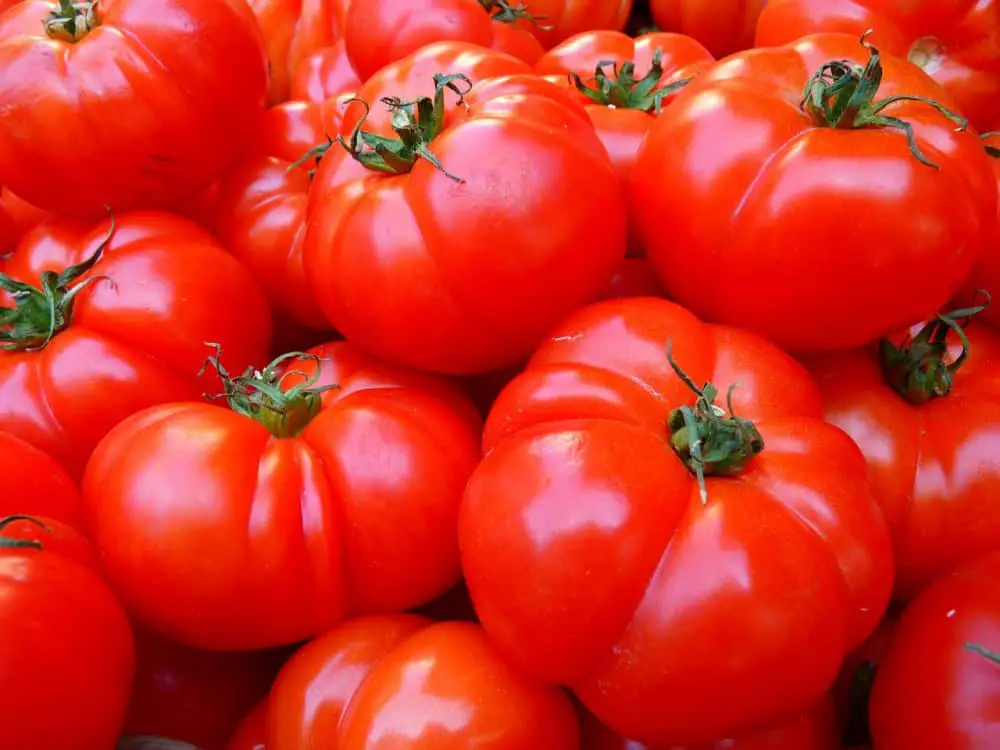Oxheart Tomato
You’re here because you want to learn about Oxheart tomato.
The Italian Oxheart tomato (or Ox Heart tomato) is an ‘old’ Italian tomato that possesses a heart shape. It’s an indeterminate variety of tomato plant.
Well, okay, not all Italian Oxheart tomatoes are of Italian origin. But one of the most favored of all Oxheart tomatoes – the Cuore Di Bue heirloom – definitely is!
The Oxheart tomato has a pretty intense flavor, while the fruits come with a meaty, thick flesh – a flesh that has little juice which makes it the perfect addition to a sandwich.

How to grow Italian Ox Heart tomato?
Plant your Italian Oxheart seeds in modules or in trays of organic compost anytime between January and March (depending on where you are in the country, or, indeed, where you are in the world).
If you’re in need of seed modules the 9GreenBox Seed Starter Trays are a great choice!
Ambient temperature should be between 65F and 70F (18 to 21C).
If preferred – if you don’t have your own seed propagator – plant your seeds in late March or April and place the trays beside a bright window in your home, or in a glasshouse.
After the initial few leaves begin to sprout and the plants reach around 3 inches in height (8cm) replant into 3-inch pots (8cm).
Aim to use a quality potting compost.
For an excellent potting mix there are ever so many available. One you may wish to try is FoxFarm Ocean Forest Organic Potting Mix:
Ambient temperature for these re-potted plants should be around 50F (10C).
You should find that your plants will grow quickly. This means they will have a need for additional nitrogen.
You can either continue to upgrade in pot size or plant your Oxheart tomatoes into grow bags. Or, if preferred, plant outside in your garden borders or in the vegetable garden. The plants should be repotted towards end of April/ May.
Once the first tomato fruit truss forms, begin feeding with something like an organic liquid feed.
To encourage healthy and abundant fruit, I like to go for a fertilizer that has a low nitrogen content and is high in potassium and phosphorus. Either that or something that’s equal in terms of everything. Why low nitrogen and high in potassium and phosphorus?
Nitrogen encourages plenty of foliage. Phosphorus encourages root growth. Potassium encourages additional fruit and healthy fruit.
A good choice of tomato fertilizer at this stage in the lifecycle is Lilly Miller Morcrop Tomato and Vegetable Food (5-10-10).
Lilly Miller Morcrop Tomato and Vegetable Food (5-10-10)
If the weather is very warm, water daily. Feed once every week or two.
Aim to keep your watering regime consistent and don’t allow the root base to get dry.
Stake or cage your tomato plants as required.
Among the best tomato cages is available from K Brands.
K Brands Tomato Cages are a good option for tomato plant staking. Support is up to 72 inches so these tomato supports are plenty high enough for taller, indeterminate tomato plants.
And don’t forget your tomato plant tie-ins. The Velcro adjustable plant ties are reusable, gentle on the plant stem, and a great price.
Velcro Adjustable Gentle Tomato Plant Ties
After your plants have set three to four fruit trusses, pinch the plant’s growing tip out. This encourages more fruiting at the expense of additional vegetative plant growth.
Remove any yellowing leaves to improve airflow and reduce opportunities for disease.
Harvesting of Oxheart tomatoes will occur between June through October.

Italian Oxheart tomato – pests and diseases
There are many pests that are attracted to tomato plants in general. Beefmaster tomatoes, Stupice tomatoes, Black Russian tomatoes, Dixie Red tomato, Celebrity tomato – you name the variety or cultivar and it could very well have at least some potential issues with aphids, whitefly, hornworms, red spider mite, and more.
Biological control is preferred, though, these days, there are numerous organic-based chemicals that are not harmful to the environment and are very effective at exterminating pests.
Read: 7 Beneficial Insects for Tomato Plants
Diseases such as blight can prove to be a problem for tomato plants.
Blight can be seen as brown patches that appear on the leaves. This can then spread to the fruit.
All blight-infected leaves should be removed immediately. Don’t add these infected leaves to your compost heap!
Why not?
Because the disease will spread within your compost. Meaning, when you use your compost the disease can then ‘potentially’ spread to other plants – typically fruit and vegetables – in your garden.
Blossom-end rot can also be a problem. This is not a disease, as such. It’s more of a physiological problem.
Read: How to Stop Blossom End Rot on Tomatoes
How to eat/ cook Ox Heart tomatoes?
Oxheart tomatoes are ideal for salads. They combine ever so well with onions, with olives, with cucumber, and with lettuce.
Oxheart tomatoes are also perfect for making salsa.
Then again, Italian Oxheart tomatoes cook very nicely to make a sauce for pasta, pizza, and ratatouille.
Perfect combination, too, when mixed with cheese in a tart, or added to a chutney, in soups, or even for homemade tomato ketchup.
When blended into a puree or passata, Italian Oxheart tomatoes can be stored in the freezer for months.






A wonderful and informative article! I can’t wait to try oxheart tomatoes next year. They sound perfect.
Hi Bonny, thanks for your appreciation! Yeah, lovely tomatoes, and well worth trying to generate your own harvest!
Regards
Joseph